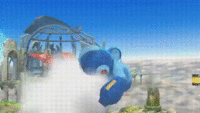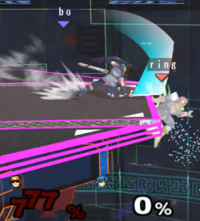| Welcome to SmashWiki! Log in or create an account and join the community, and don't forget to read this first! |
| Notices |
|---|
| The Skill parameter has been removed from Smasher infoboxes, and in its place are the new "Best historical ranking" and "Best tournament result" parameters. SmashWiki needs help adding these new parameters to Smasher infoboxes, refer to the guidelines here for what should be included in these new parameters. |
| When adding results to Smasher pages, include each tournament's entrant number in addition to the player's placement, and use the {{Trn}} template with the matching game specified. Please also fix old results on Smasher pages that do not abide to this standard. Refer to our Smasher article guidelines to see how results tables should be formatted. |
| Check out our project page for ongoing projects that SmashWiki needs help with. |
Tech: Difference between revisions
(Text formatting doesn't want to play nice with me today.) |
|||
| Line 46: | Line 46: | ||
===''[[Super Smash Bros. 4]]''=== | ===''[[Super Smash Bros. 4]]''=== | ||
''Smash 4''{{'}}s mechanics to teching are fundamentally similar to ''Brawl''{{'}}s. However, the mechanics have gone under several significant changes: a tech now has a window of eight frames before it can be succesfully inputted, rather than twenty, but the forty frame penalty before a character can tech again remains. In addition, a tech can no longer be inputted or buffered during [[hitlag]], and hitlag now overlaps with the lag suffered by the character when recoiling from a surface before bouncing off of it. If the hitlag would have ended before the character's recoil lag ends, the hitlag and recoil lag synchronize. Effectively, these changes mean that if a character is hit while touching a wall, they cannot tech on that wall, potentially leading to unavoidable stage spikes. Additionally, characters can no longer tech on the ground while [[tumbling#Reeling|reeling]], for at least until the hitstun cancel window begins. However, [[meteor smash]]es that land on grounded opponents are now techable, provided their hitlag does not exceed the length of the tech input window. The only meteor smash with enough hitlag to be untechable under normal circumstances is {{SSB4|Ganondorf}}'s down aerial, although {{SSB4|Falco}}'s down aerial also had this property prior to update [[1.0.8]]. Because of this, teching now requires extreme precision in order to be inputted | ''Smash 4''{{'}}s mechanics to teching are fundamentally similar to ''Brawl''{{'}}s. However, the mechanics have gone under several significant changes: a tech now has a window of eight frames before it can be succesfully inputted, rather than twenty, but the forty frame penalty before a character can tech again remains. In addition, a tech can no longer be inputted or buffered during [[hitlag]], and hitlag now overlaps with the lag suffered by the character when recoiling from a surface before bouncing off of it. If the hitlag would have ended before the character's recoil lag ends, the hitlag and recoil lag synchronize. Effectively, these changes mean that if a character is hit while touching a wall, they cannot tech on that wall, potentially leading to unavoidable stage spikes. Additionally, characters can no longer tech on the ground while [[tumbling#Reeling|reeling]], for at least until the hitstun cancel window begins. However, [[meteor smash]]es that land on grounded opponents are now techable, provided their hitlag does not exceed the length of the tech input window. The only meteor smash with enough hitlag to be untechable under normal circumstances is {{SSB4|Ganondorf}}'s down aerial, although {{SSB4|Falco}}'s down aerial also had this property prior to update [[1.0.8]]. Because of this, teching now requires extreme precision in order to be inputted. | ||
{{SSB4|Cloud}}'s [[Climhazzard]] is coded intentionally to prevent him from being able to perform any kind of tech near the apex of both versions of the move if he gets hit and tumbles. This does not apply to his reeling animation, and attempting to grab him or hit him more than once allows him to tech after the last launching hit. | |||
==Usefulness and application== | ==Usefulness and application== | ||
Revision as of 17:31, May 29, 2017
A tech, officially referred to as a breakfall in Super Smash Bros., an ukemi (受け身) in Super Smash Bros. Brawl, breaking your fall in Smash 4, and passive internally in Melee and Brawl, is an action that can be performed when the player's character hits the ground, a wall, or a ceiling while tumbling or in hitstun. To tech, the user must press the shield button a couple of frames before hitting the surface; after that, a player won't be able to tech for fourty frames. Additional button or control stick input can cause different types of techs.
The word "ukemi" refers to a rolling technique used in Japanese martial arts when taking an attack. The name has found its way into several (mostly fighting) games, such as the Soul series, to describe similar fall recovery moves.
The word "tech" is borrowed from the competitive communities of other fighting games and traces its origin back to technical bonuses awarded in Capcom games for performing special maneuvers to escape grab attacks and get much less damage and more recovery time.
Types of techs
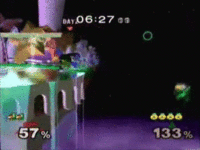
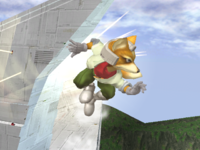
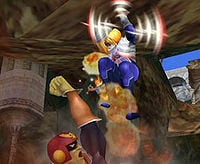
Standard tech
A standing tech, standard tech, or neutral tech is a neutral, ground-based tech performed by pressing a shield button when a tumbling character comes in contact with the floor. The character will experience a brief period of invincibility, and will quickly bounce from the ground into a standing animation. The player will also grab any items that he or she comes in contact with.
Rolling tech
A rolling tech (or PassiveStandF and PassiveStandB, depending on the direction chosen), also called a techroll, is a ground-based tech performed by tilting the control stick left or right when teching. The character will bounce from the ground into a roll-like animation during which the character moves left or right while invincible. This can allow characters to roll away from their impact point to complicate tech chasing, but rolling against an edge will halt the roll's sideways movement.
An Amsah tech (named after Dutch player Amsah) is the combination of a rolling tech and directional influence in Melee that can be used to survive low knockback-angle attacks like Falco's down smash. It is performed by DIing down and towards the attacking character, holding the C-Stick down for ASDI, and pressing L or R during hitlag. It is also referred to as an Over tech, named after Spanish player Overtriforce.
Wall tech
A wall tech (or PassiveWall) is a tech against a wall. To wall tech, the player must press a shield button before hitting a wall while tumbling, reeling, or in hitstun. Twenty frames after each press is a fourty frame downtime window where a wall tech cannot be done, so button mashing reduces the player's likelihood of teching. As with normal techs, the wall teching character experiences a few invincibility frames, and the tech absorbs the player's momentum. Wall teching is useful even on simple stages with no onstage walls, as the player can tech the side of the stage to avoid being stage spiked.
Ledge tech
A recovering character can use a form of wall tech to survive an edge-guarder. If the recovering character is hit with an attack very near to a stage's edge, they can smash DI towards the edge and wall tech to absorb all the knockback of the enemy's attack. This is usually performed by pressing the shield button to wall tech before pressing the control stick to DI, because of the 20 frame window in which the player can input the tech before hitting the wall.
Wall tech jump/Wall jump tech
If a jump input is active when a wall tech is performed (such as holding Up or pressing a jump button), then the teching character will wall jump. This is known as a wall tech jump. Every character can wall tech jump, even those who cannot wall jump normally. A skilled player can survive a meteor smash (such as the Ice Climbers' forward aerial that often ends their chaingrabs) by wall tech jumping.
Ceiling tech
A ceiling tech (or PassiveCeil) is a tech against a ceiling. To ceiling tech, the player must press the shield button 20 frames or fewer before hitting the ceiling, while in hitstun. 20 frames after each press is a 40 frame downtime window where a ceiling tech cannot be done, so mashing buttons reduces the player's likelihood of teching. As with normal techs, the ceiling teching character experiences a few invincibility frames, and the tech absorbs most of the momentum. It is shown on the Super Smash Bros. Brawl tutorial video on the Nintendo Channel that it can even save a character at 999%. There are few situations where there is a ceiling for a player to tech off of, but it can occur if the player is hit underneath the stage, and can happen quite frequently in the caves of life in some stages.
Changes between games
Super Smash Bros.
In Smash 64, only ground techs are available (standing and rolling), so on stages with many walls it can be difficult to avoid bouncing combos. Teching is possible for the first twenty frames before the character touches the ground.
Super Smash Bros. Melee
In addition to normal techs, Melee introduced of wall techs, wall jump techs, and ceiling techs. The mechanics to teching are fundamentally the same ones as the Smash 64 mechanics, being able to be performed for the first twenty frames before the character touches the ground, a wall, an edge or the ceiling, plus the character's recoil frames when they hit a surface.
Super Smash Bros. Brawl
While the mechanics to teching are similar to those of Melee, Brawl removed the ability to tech a hit while on the edge of a stage, as well as buffering a tech before one even received a hit. Additionally, as the new air dodge physics allow airdodges to be used while tumbling, trying to tech too early will simply result in an air dodge. As a result, teching often requires more precision to perform in Brawl.
Super Smash Bros. 4
Smash 4's mechanics to teching are fundamentally similar to Brawl's. However, the mechanics have gone under several significant changes: a tech now has a window of eight frames before it can be succesfully inputted, rather than twenty, but the forty frame penalty before a character can tech again remains. In addition, a tech can no longer be inputted or buffered during hitlag, and hitlag now overlaps with the lag suffered by the character when recoiling from a surface before bouncing off of it. If the hitlag would have ended before the character's recoil lag ends, the hitlag and recoil lag synchronize. Effectively, these changes mean that if a character is hit while touching a wall, they cannot tech on that wall, potentially leading to unavoidable stage spikes. Additionally, characters can no longer tech on the ground while reeling, for at least until the hitstun cancel window begins. However, meteor smashes that land on grounded opponents are now techable, provided their hitlag does not exceed the length of the tech input window. The only meteor smash with enough hitlag to be untechable under normal circumstances is Ganondorf's down aerial, although Falco's down aerial also had this property prior to update 1.0.8. Because of this, teching now requires extreme precision in order to be inputted.
Cloud's Climhazzard is coded intentionally to prevent him from being able to perform any kind of tech near the apex of both versions of the move if he gets hit and tumbles. This does not apply to his reeling animation, and attempting to grab him or hit him more than once allows him to tech after the last launching hit.
Usefulness and application
Teching can be a lifesaver in many situations and is a good technique for beginners to learn and practice. Teching can also help the user escape from combos.
Occasionally after accumulating sufficient damage, one will experience a wall or ceiling rebound that will send the player plummeting off-stage. This can be prevented by applying a wall or ceiling tech, saving the player from a deadly ricochet. This is especially useful in caves of life, e.g. Temple: a character in the large lower section of the stage can survive to very high damage and can immediately retaliate from otherwise-deadly blows. This unusual longevity is one reason Temple and similar stages are banned from tournaments.
The standing and rolling techs can be performed in more situations, such as allowing a character to avoid continued assault after being knocked back. However, an opponent can frequently predict a player's tech patterns and strike him or her again after knocking him or her down; deliberately setting up such situations is known as "tech-chasing".
Edge-teching helps keep the character on the stage, or at least making it possible to recover to the stage.
Gallery
Yoshi performing a tech in Brawl.
Captain Falcon performing a tech in Smash 64.
Ganondorf performing a wall jump tech, and counterattacking with a forward aerial.
